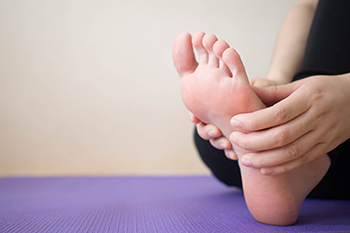Treatments for Plantar Fibroma

Plantar fibromas are small lumps that develop in the sole of the foot and can cause foot arch pain in some cases. Treatment aims to reduce pressure on the nodule and alleviate pain. Treatment options include observation if the fibroma is not causing significant pain and non-surgical treatments like exercises. Other options are corticosteroid injections, shoe orthotics if the pain is mild to moderate, and surgery if the pain is severe and non-responsive to non-surgical methods. Exercises focus on stretching and strengthening the plantar fascia and surrounding tissues, to reduce tension on the fibroma. Corticosteroid injections can provide immediate pain relief and reduce the size of the nodule. Orthotics help relieve pressure on the nodules, although custom orthotics may be needed for larger nodules. Physical therapy may include ultrasound or shockwave therapy to reduce the size of the nodules, and radiotherapy can stabilize and shrink fibromas. Surgery is considered a last resort and involves removing the fibroma along with a portion of the plantar fascia. Recovery from plantar fibromas can take 6 to 12 months, during which modifications to activities and foot care are essential. If you think you have a plantar fibroma, it is suggested that you make an appointment with a podiatrist. Other conditions can cause similar symptoms, so proper diagnosis is important and then the most suitable treatment can be recommended.
A plantar fibroma may disrupt your daily activities. If you have any concerns, contact one of our podiatrists of Comprehensive Foot & Ankle Center of South Jersey. Our doctors can provide the care you need to keep you pain-free and on your feet.
Plantar Fibroma
A plantar fibroma is a fibrous knot in the arch of the foot. It is embedded in the plantar fascia which is a band of tissue that extends from the heel to the toes along the bottom of the foot. There can be multiple plantar fibromas in the feet at the same time. There are no known causes for this condition. If you have a plantar fibroma, there will be a bump in the arch of your foot that cannot be missed. Any associated pain is most often due to a shoe rubbing against the nodule. Non-surgical options, such as steroid injections, physical therapy, and orthotics should be tried first. Surgery is a last resort and is the only thing that will remove a plantar fibroma entirely. Consult with a podiatrist for a proper diagnosis and to determine the treatment regimen that is right for you.
What Causes a Plantar Fibroma?
While there are no specific causes identified, a plantar fibroma can possibly come from genetic predisposition or the formation of scar tissue that forms from healing the tears in the plantar fascia.
What Are the Symptoms of a Plantar Fibroma?
There will be a noticeable lump in the arch of the foot that may or may not cause pain. If pain is felt, it is typically because a shoe is rubbing up against the lump or when walking or standing barefoot.
Treatment and Prevention
A plantar fibroma will not disappear without treatment, but it can get smaller and be a non-issue. If pain persists, a podiatrist examines the foot and when the arch of the foot is pressed, pain can be felt down to the toes. An MRI or biopsy might be performed to help diagnose or evaluate the plantar fibroma. The following non-surgical options are generally enough to reduce the size and pain of these nodules:
- Steroid injections
- Orthotics
- Physical therapy to help apply anti-inflammatory creams on the bump
Surgery is considered if the mass increases in size and the patient continues to feel pain after non-surgical methods are tried.
If you have any questions please feel free to contact our offices located in Cherry Hill, Voorhees, Atco, and Turnersville, NJ . We offer the newest diagnostic tools and technology to treat your foot and ankle needs.
